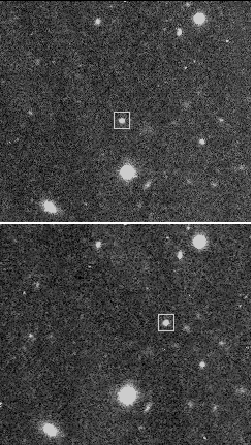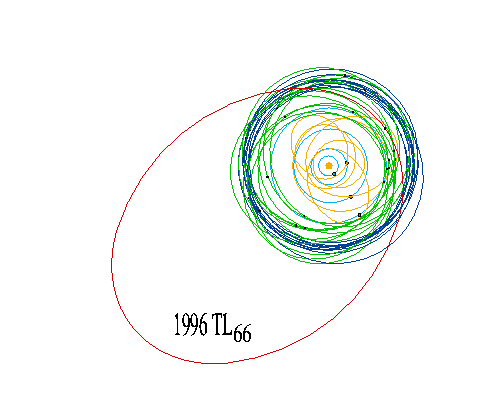

|
1996 TL66
|
|---|
| A New Dynamical Class in the Outer Solar System |
TL66 was discovered during a wide-area survey of the trans-Neptunian solar system at the UH2.2 meter telescope. We employed an 8192 x 8192 pixel CCD camera to image wide swaths of the sky in search of slow moving objects. The data were reduced in near real-time, and fed to automated moving object detection software (MODS) running on an Ultrasparc at the Hale-Pohaku base camp on Mauna Kea. Output from this program is examined visually to determine the reality of candidate moving objects from the MODS. We then obtained additional astrometry within the discovery run, and in following months, in order to better constrain the orbital parameters.
Sample images of 1996 TL66 from the discovery run are shown in Figure 1.
The orbit of 1996 TL66 is different from those of other known Kuiper Belt Objects, in that it is highly eccentric (e = 0.59) with a semimajor axis (a = 85 AU) about twice as large as for typical members of the classical Kuiper Belt (see Figure 2). The orbit of TL66 is also inclined to the plane of the solar system by 24 degrees, which is larger than the inclinations of most (but not all) other known Kuiper Belt Objects. TL66 is also noteworthy for its large size. From the apparent magnitude (21) and an assumed 0.04 albedo, we estimate that the diameter is about 500 km. All in all, it is a remarkable object.
From the small area of the sky in which it was discovered, and from the fact that it spends most of its 1000 year orbital period too far from the sun to be detected in our 8k CCD survey, we estimated that about 10,000 similar objects exist. Presumably, a large number of smaller objects are also present in inclined, eccentric orbits with large semi-major axes. The combined mass may approach 0.5 to 1 Earth mass, possibly larger than the mass of the known Kuiper Belt.
More discussion may be found in our paper on TL66: Luu et al. (1997) "A New Dynamical Class of Object in the Outer Solar System". Nature, 387, 573.
 |
Kuiper Belt |
|---|
Last Update August 2009